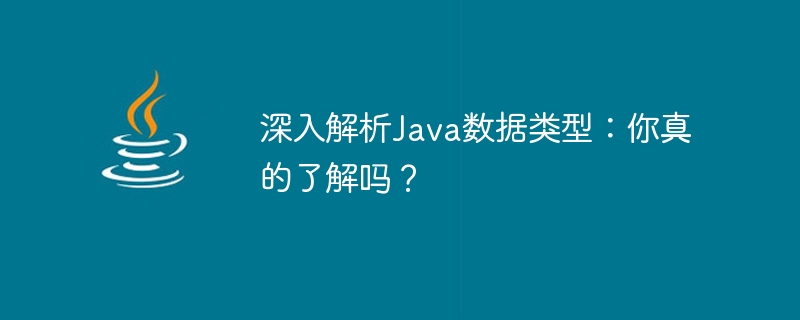Home >Java >javaTutorial >Explore the mysteries of Java data types: Is your knowledge comprehensive?
Explore the mysteries of Java data types: Is your knowledge comprehensive?
- WBOYWBOYWBOYWBOYWBOYWBOYWBOYWBOYWBOYWBOYWBOYWBOYWBOriginal
- 2024-02-18 18:54:211302browse

In-depth analysis of Java data types: Do you really understand them?
Java is a widely used programming language with rich data types for processing various data. We may have a certain understanding of the common data types provided by Java, such as integers, floating point numbers, characters, etc., but in fact there are many other types in Java. By in-depth understanding of these data types, we can better grasp Java's data processing capabilities. .
- Basic data types
First, let us review the basic data types provided by Java. These types include integer types (byte, short, int, long), floating point types (float, double), Boolean types (boolean), and character types (char). These data types are widely used in Java, and we often use these types to declare variables and perform basic operations.
The following is a sample code that operates on basic data types:
int a = 10;
float b = 3.14f;
char c = 'A';
// 整数加法
int sum = a + 5;
System.out.println("sum = " + sum);
// 浮点数乘法
float result = b * 2;
System.out.println("result = " + result);
// 字符转换为ASCII码值
int ascii = (int)c;
System.out.println("ASCII value = " + ascii);- Reference data types
In addition to basic data types, Java also provides Various reference data types enable us to handle more complex data structures. Common reference data types include String, Array, Class, etc.
String is a special reference type that can be expressed using double quotes. Java provides many operation methods for strings, such as getting the length of a string, concatenating two strings, etc. The following is a sample code for string operations:
String s1 = "Hello";
String s2 = "World";
// 字符串连接
String result = s1 + " " + s2;
System.out.println(result);
// 获取字符串长度
int length = s1.length();
System.out.println("Length of s1 = " + length);An array is a reference type used to store multiple data of the same type. You can access array elements through indexes and perform a series of operations, such as sorting, searching, etc. The following is a sample code for array operations:
int[] array = {1, 2, 3, 4, 5};
// 计算数组元素和
int sum = 0;
for (int i = 0; i < array.length; i++) {
sum += array[i];
}
System.out.println("Sum of array = " + sum);
// 查找数组中的最大值
int max = array[0];
for (int i = 1; i < array.length; i++) {
if (array[i] > max) {
max = array[i];
}
}
System.out.println("Max value in array = " + max);Class is one of the most important reference data types in Java, used to define the properties and behavior of objects. Through the instantiation of a class, we can create an object and call the object's methods. The following is a class definition and usage example code:
class Person {
String name;
int age;
void introduce() {
System.out.println("My name is " + name + ", I am " + age + " years old.");
}
}
// 创建Person对象
Person p = new Person();
p.name = "Tom";
p.age = 25;
p.introduce();By having an in-depth understanding of Java's data types, we can operate data more flexibly and write efficient and maintainable code. At the same time, understanding the characteristics of different data types also helps us optimize code execution efficiency and memory usage.
To sum up, Java provides a wealth of data types for processing different types of data, and provides corresponding operation methods. By fully understanding and mastering these data types, we can better write Java programs and give full play to Java's data processing capabilities. I hope this article can help readers gain a deeper understanding of the use of Java data types.
The above is the detailed content of Explore the mysteries of Java data types: Is your knowledge comprehensive?. For more information, please follow other related articles on the PHP Chinese website!

